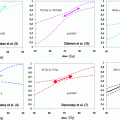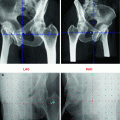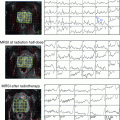Fig. 1
Dose distribution with an IMRT plan for salvage RT of the prostatic fossa, prescribed dose 66 Gy, 7 beams (XIO®, Elekta). Pink prostatic fossa, white clinical target volume, orange planning target volume, yellow bladder, blue rectum
The role of modern RT techniques in the post-prostatectomy setting is not well defined, due to the lack of prospective studies in this area. Some recent trials have compared the dose distribution of CRT and IMRT, with a superiority of IMRT regarding the coverage of the prostate bed and the reduction of radiation dose to the organs at risk (Riou et al. 2012).
Most published retrospective clinical studies have included patients treated over decades with different RT techniques. In the past couple of years, evidence from single institution experiences has emerged on the role of modern techniques in the salvage RT setting. A retrospective study from the Memorial Sloan-Kettering Cancer Center has demonstrated lower rates of late GI toxicity with IMRT than with CRT. Late GU-toxicity was not influenced by the RT technique. It is important to note, that the majority of the patients in this study were treated with doses ≥70 Gy (Goenka et al. 2011). An Italian retrospective study demonstrated lower rates of acute upper GI toxicity with IMRT than with CRT, probably because of better sparing of small bowel through IMRT (Alongi et al. 2009). Quite favorable acute and late GU/GI toxicity rates have been reported in a single institution study of image-guided IMRT (Nath et al. 2010). IMRT is particularly attractive in the case of pelvic nodal irradiation from the dosimetric point of view (Digesú et al. 2011).
The authors believe that the use of highly conformal techniques for salvage RT is justified. Whether IMRT and image-guided RT (IGRT) lead to a better outcome or limit treatment-related toxicity, cannot be definitely answered based on current evidence. However, the so far published results from small retrospective trials seem promising. Therefore IMRT and IGRT should be used, whenever they are available.
7 Treatment Outcome
Treatment outcome after salvage RT for biochemical relapse is defined as:
(a)
response to treatment
(b)
bPFS
(c)
incidence of acute and late treatment related toxicity.
Response to treatment describes the percentage of patients, who will experience a PSA drop after salvage RT. This measure indicates how many patients had—at least in part—a biochemical relapse because of a microscopic local recurrence. The range of possible PSA response differs from study to study, due to differences in patient characteristics and the proportion of patients also receiving concomitant ADT. Published series have shown PSA-response rates of 80–95 % (Pazona et al. 2005; Buskirk et al. 2006; Pisansky et al. 2000; Neuhof et al. 2007; Stephenson et al. 2004).
The biggest published series reported bPFS at 5-year post-treatment in the range of 35–45 % (Buskirk et al. 2006; Ward et al. 2004; Pisansky et al. 2000; Neuhof et al. 2007; Stephenson et al. 2004; Geinitz et al. 2012). Interestingly the Kaplan–Meier-plots show a continuous drop in bPFS even beyond 5 years after treatment. These late relapses could be indicative of secondary tumor relapse in the prostatic fossa rather than activated micrometastatic disease because of the long interval following primary treatment.
The incidence of acute and late treatment-related toxicity has been inconsistently reported in published trials. Late treatment-related toxicity seems to be in the range known from adjuvant RT trials. In a large review late Grade 2 GU and GI toxicity was evident in 10 and 4 % of all patients respectively, while less than 1 % of all patients experienced Grade 3 toxicity (Feng et al. 2007). Compromising urinary continence is a major concern in salvage RT. Patients with incomplete continence before salvage RT are almost four times more likely to suffer from urinary incontinence at 3 years after treatment, than those who had complete urinary continence before salvage RT (Pearse et al. 2008).
Nevertheless, in the majority of the retrospective trials, the applied total doses have been below 70 Gy, and may in the near future be considered too low. With increasing dose, increasing toxicities might result, especially while the urinary tract cannot be spared even with modern RT techniques. Dose escalation trials are necessary, and have to be carried out carefully.
One critical point concerning the value of salvage RT in prostate cancer is the potential influence of a prolonged bPFS on CSS and overall survival. Data from retrospective studies provide conflicting evidence. One study found no decreased mortality with salvage RT despite a large benefit in bPFS (Boorjian et al. 2009). On the other hand, two studies provide retrospective evidence in larger patient populations, that CSS can be increased through salvage RT in patients having both a short (<6 months) and long (≥6 months) PSA-doubling time (Trock et al. 2008; Cotter et al. 2011).
8 Treatment Escalation: Radiation Dose
Average salvage RT doses given in most retrospective studies ranged from 64 to 70 Gy. The NCCN and EAU guidelines (NCCN 2012; European Urology Association Guidelines on Prostate Cancer 2012) recommend a salvage RT dose of 64–68 Gy and 64–66 Gy, respectively. In fact these recommendations seem reasonable, considering there are no prospective dose-comparing studies for salvage RT and that higher doses may potentially lead to treatment-related toxicities. On the other hand, some authors advocate dose escalation in salvage RT as well (King 2012; King and Spiotto 2008; King and Kapp 2008), based on the experience of dose escalation in primary RT for prostate cancer (Viani et al. 2009). The interesting dose level seems to be in the direction of 70 Gy, within the steep part of the dose–effect curve and a projected 2–3 % absolute gain in bPFS per additional Gy of RT dose (King 2012; King and Kapp 2008). Higher doses of salvage RT, however, may be associated with late treatment-related toxicity, as for example shown in an IMRT-study with 75 Gy to the prostatic fossa leading to 30 % Grade 2 GU-toxicity (Meerleer et al. 2008). Recently, a radiobiological model has been proposed to predict the impact of dose escalation in salvage RT on terms of bPFS and GI/GU-toxicity (Ohri et al. 2012).
The authors recommend a salvage RT dose of 64–66 Gy for the majority of patients undergoing salvage RT. Selected patients with intact urinary continence may benefit from a dose escalation to 70 Gy. In patients with macroscopic disease recurrence in the prostatic fossa it seems plausible to prescribe higher RT doses (70–74 Gy).
9 Treatment Escalation: Androgen Deprivation Therapy (ADT)
Randomized trials have shown that ADT given concomitantly to primary RT for prostate cancer can improve overall survival (Nguyen et al. 2011). This effect is attributed both to absolute tumor cell kill within the prostate as well as battling micrometastatic disease. The absolute number of tumor cells in the prostatic fossa in case of a biochemical relapse should be rather low (provided a macroscopic recurrence is excluded and treatment started at an early timepoint). Thus, the main target for ADT additional to salvage RT should be micrometastatic disease. On the other hand, if dose escalated salvage RT leads to higher bPFS (King and Spiotto 2008; King and Kapp 2008), the concomitant use of ADT in patients with only low risk of systemic disease may only be beneficial when standard dose salvage RT (64–66 Gy) is prescribed.
Two prospective trials have combined salvage RT with LHRH-analog either for 2 years within a phase-II—or until tumor progression within a randomized phase-III-trial, demonstrating excellent results in terms of bPFS (78 % at 7 years and 65 % at 5 years), far superior to those reported by retrospective trials on salvage RT alone (Choo et al. 2009; Corn et al. 1999). Both trials could not demonstrate a better local control, metastasis-free survival or overall survival, questioning the real value of immediate androgen suppression instead of delayed use of hormonal treatment if deemed necessary (Corn et al. 1999).
Small retrospective studies also show a trend for better bPFS through combined modality treatment, the interpretation of these results hampered however due to limited follow-up and possible selection bias (Katz et al. 2003; Tiguert et al. 2003; Taylor et al. 2003; King et al. 2004). Preliminary results of the randomized RTOG 9601 trial comparing salvage RT with or without 24 months of bicalutamide show a superior bPFS and a decreased cumulative incidence of distant metastasis in the combined modality arm. The effect of combined treatment on the primary trial endpoint overall survival is however not yet visible at 7 years of follow-up (Shipley et al. 2011).
Since ADT is the standard treatment following biochemical failure after salvage RT, one must question whether bPFS and MFS are eligible endpoints when comparing the outcome after salvage RT or combined salvage RT and ADT. Overall survival may not be influenced, if ADT is given at first upon further disease progression after salvage RT and may therefore represent a more appropriate endpoint. The possible impairment of quality of life through ADT (especially if given over a longer period of time, like in the RTOG 9601 trial) should also be considered.
The authors believe, that salvage RT for biochemical relapse should be given without ADT, until definite results from randomized trials are available showing an improved overall survival while preserving a high quality of life in those men. Patients with macroscopic recurrence can be treated with combined RT and ADT, because of the higher local tumor load. This strategy is based on the favorable results of combined RT and ADT in primary prostate cancer treatment (Nguyen et al. 2011).
10 Future Directions: Running Trials
A considerable number of randomized trials (Table 1) are currently underway, seeking answers to important questions in the field of postoperative RT for prostate cancer.
The RTOG 0534 trial is randomizing patients to salvage RT of the prostatic fossa with or without ADT, while in the third study arm patients are receiving additional RT of the pelvic lymph nodes (Prostate radiation therapy 2012). A UK-led trial is testing multiple questions by randomizing patients to immediate postoperative or salvage RT with or without ADT of different durations (Radiation therapy and androgen deprivation therapy 2012). A similar approach is being followed in an EORTC-trial, randomizing patients to adjuvant or salvage RT with or without ADT (Radiation therapy with or without hormone therapy 2012). Adjuvant versus salvage treatment with a combination of RT and ADT is the focus of an active French trial (Radiation therapy with or without Goserelin 2012). A Japanese randomized trial has completed accrual testing salvage ADT with or without RT (Trial to evaluate radiotherapy 2012). The Trans-Tasman Radiation Oncology Group (TROG) is randomizing patients to adjuvant or early salvage RT (Radiotherapy—Adjuvant Versus Early Salvage (RAVES 2012). The MAPS-study is looking at focal dose escalation through integrated boost techniques based on dynamic contrast-enhanced MRI (Radiation therapy in treating patients 2012). A more straightforward approach is being followed by a Swiss-German trial, which is testing dose escalation (64 vs. 70 Gy) to the prostatic fossa with special interest to modern RT techniques (Radiation therapy in treating 2012).
It is expected, that these trials will shed light in the field of postoperative RT by directly answering critical questions on timing of treatment as well as necessity of RT dose escalation and value of ADT. Further retrospective analyses of the large groups of patients to be included in these trials in combination with tissue analysis may help us to clarify which groups of patients are served the best with more or less aggressive treatment approaches.
11 Conclusions
Salvage RT is the sole potentially curative treatment for biochemical relapse after RP in patients with prostate cancer. Salvage RT should be performed as early as possible, ideally with a PSA-value between 0.2 and 0.5 ng/ml. Since it is not clear, which groups of patients will not benefit from such a potentially curative treatment, salvage RT should not be withheld from any subgroup of patients with biochemical relapse. The optimal timing and dose of postoperative RT as well as its combination with ADT are currently being tested in phase-III trials. Patients with biochemical relapse after RP should be treated whenever possible within clinical trials in order to answer these open questions as soon as possible.
Outside clinical trials 64–72 Gy are the standard dose of salvage RT, the exact dose to be defined by absence or presence of macroscopic recurrence and the urinary continence status of the patient prior to treatment.
Table 1
Overview of active studies on postoperative RT
Title | Setting | Randomization | Inclusion criteria | Primary endpoint | Status |
|---|---|---|---|---|---|
RTOG 0534 (Shipley et al. 2011) | Salvage | 1. Prostatic fossa RT 2. Prostatic fossa RT + ADT (4–6 months) 3. Prostatic and pelvic node RT + ADT (4–6 months) | PSA ≥ 0.1 < 2.0 ng/ml R0-1 GS ≤ 8 | Freedom from progression | Active since 02/08 |
RADICALS (Radiation therapy and androgen deprivation therapy 2012) | Adjuvant versus early salvage | First randomization 1. Adjuvant RT 2. Early salvage RT Second randomization 1. RT 2. RT + ADT (6 months) 3. RT + ADT (24 months) | First randomization PSA ≤ 0.2 ng/ml one or more – pT3/4 – GS 7–10 – pre-RP PSA > 10 ng/ml – R1 | Disease specific survival | Active since 10/07 |
EORTC 22043 (Radiation therapy with or without hormone therapy 2012) | Adjuvant and early salvage | Adjuvant setting 1. RT 2. RT + ADT (6 months) Early salvage setting 1. RT 2. RT + ADT (6 months) | pT2 R1 or pT3 R0-1 GS 5–10 Adjuvant setting PSA < 0.2 ng/ml Early salvage setting PSA < 0.5 or 3 rises | bPFS at 5 years | Active since 05/09 |
GETUG 17/0702 (Radiation therapy with or without Goserelin 2012)
Stay updated, free articles. Join our Telegram channel
Full access? Get Clinical Tree
 Get Clinical Tree app for offline access
Get Clinical Tree app for offline access

|



